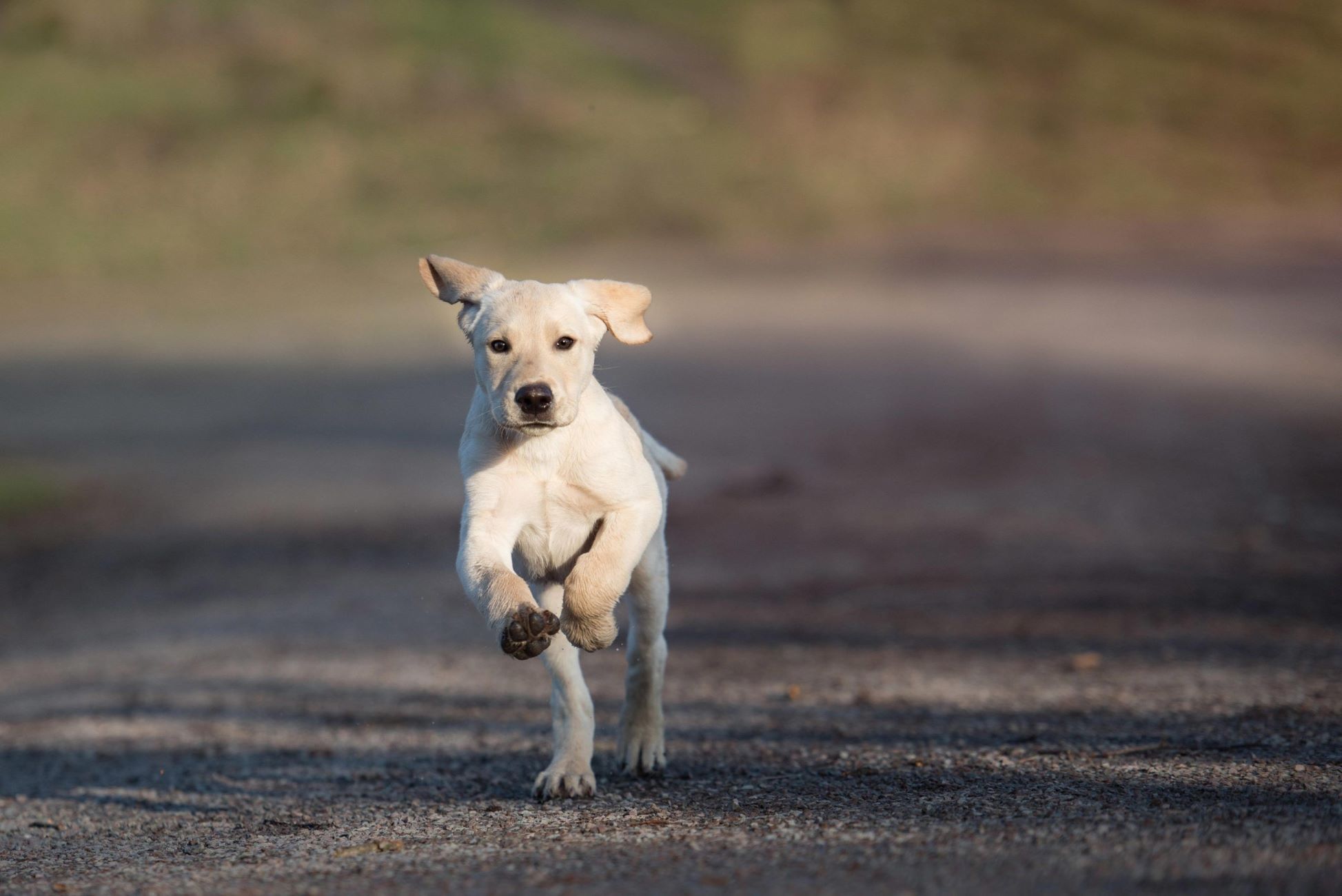Home>Health & Nutrition>Running With Your Dog: A Guide To The Dos And Don’ts


Health & Nutrition
Running With Your Dog: A Guide To The Dos And Don’ts
Published: February 24, 2024
Discover the dos and don'ts of running with your dog for optimal health and nutrition. Learn how to keep your furry friend in top shape while enjoying your runs together.
(Many of the links in this article redirect to a specific reviewed product. Your purchase of these products through affiliate links helps to generate commission for Therunningadvisor.com, at no extra cost. Learn more)
Table of Contents
Introduction
Running with your dog can be an incredibly rewarding experience for both you and your furry companion. It's a fantastic way to bond, stay active, and enjoy the great outdoors together. Whether you're a seasoned runner or just starting out, having your dog by your side can add an extra layer of motivation and joy to your workouts.
As a dog owner, you already know the unconditional love and companionship that your pet provides. Taking your dog along for a run not only benefits your physical health but also contributes to your dog's overall well-being. The rhythmic sound of paws hitting the pavement, the shared sense of accomplishment, and the sheer joy of spending quality time together can create a unique and special bond between you and your four-legged friend.
Before you hit the trails, it's important to understand the dos and don'ts of running with your dog. From choosing the right gear to ensuring your dog's safety, there are several factors to consider to make the experience enjoyable for both of you. This guide will provide you with valuable insights into the benefits of running with your dog, tips for selecting the appropriate gear, and essential dos and don'ts to keep in mind as you embark on this adventure together.
So, lace up your running shoes, grab your dog's leash, and get ready to explore the world of running with your canine companion. Whether you have a high-energy breed that's always raring to go or a more laid-back pup who enjoys a leisurely jog, this guide will equip you with the knowledge and confidence to make your running sessions with your dog safe, enjoyable, and fulfilling.
Benefits of Running with Your Dog
Running with your dog offers a myriad of benefits that extend beyond physical fitness. The experience can be incredibly enriching for both you and your furry companion. Here are some compelling reasons why hitting the pavement with your dog can be a game-changer for your overall well-being:
-
Physical Health: Running is an excellent form of cardiovascular exercise, and having your dog as a running partner can motivate you to stay consistent with your workouts. The physical benefits extend to your dog as well, as regular exercise helps maintain their weight, strengthens their muscles, and improves their overall fitness.
-
Mental Stimulation: Dogs thrive on mental stimulation, and the sights, sounds, and scents encountered during a run can provide valuable enrichment for your pet. The ever-changing outdoor environment can engage your dog's senses, keeping their mind active and curious.
-
Bonding and Socialization: Running together creates a unique opportunity for bonding. The shared experience of conquering a trail or completing a run can strengthen the emotional connection between you and your dog. Additionally, encountering other runners, walkers, and dogs during your outings can help improve your dog's socialization skills.
-
Stress Reduction: Exercise, including running, is known to reduce stress and anxiety in both humans and dogs. The endorphins released during physical activity can elevate mood and alleviate tension, contributing to a sense of well-being for both you and your dog.
-
Improved Behavior: Regular exercise can help curb behavioral issues in dogs, such as excessive barking, chewing, or digging. Running provides an outlet for your dog's energy, reducing the likelihood of destructive behaviors at home.
-
Enhanced Safety and Security: Running with your dog can provide an added layer of security, especially during early morning or evening runs. Your dog's presence can offer reassurance and protection, making you feel safer during outdoor workouts.
-
Accountability and Motivation: Dogs thrive on routine, and having a running schedule can instill a sense of consistency and structure in both your lives. Your dog's enthusiasm and eagerness to run can serve as a powerful motivator, encouraging you to lace up your shoes and head out, even on days when you might feel less inclined to exercise.
Incorporating your dog into your running routine can transform your workouts into enjoyable and meaningful experiences. The physical, mental, and emotional benefits of running with your dog underscore the profound impact that this activity can have on your lives.
Choosing the Right Gear
Selecting the appropriate gear is crucial when it comes to running with your dog. The right equipment not only ensures your comfort and safety but also contributes to your dog's well-being during the run. Here's a comprehensive guide to choosing the right gear for a seamless and enjoyable running experience with your furry companion.
Leash and Harness
Invest in a sturdy, well-fitted leash and harness for your dog. Opt for a hands-free leash that allows you to maintain a natural running posture while keeping your dog close. The leash should be reflective for visibility during low-light conditions, and the harness should be comfortable and secure, preventing any chafing or discomfort for your dog.
Collapsible Water Bowl
Staying hydrated is essential for both you and your dog during a run. A collapsible water bowl is a convenient accessory that allows you to offer water to your dog at regular intervals. Look for a lightweight, portable bowl that can be easily carried during your runs.
Read more: Top 6 Dog Breeds For Running
Running Belt or Pack
Consider using a running belt or pack to carry essentials such as waste bags, treats, and your phone. Look for a belt with multiple pockets to keep your hands free and ensure that you have everything you need for a successful run with your dog.
Dog Booties
If you frequently run on rough terrain or in extreme weather conditions, dog booties can protect your dog's paws from hot pavement, sharp rocks, or icy surfaces. Choose booties that are durable, breathable, and provide a secure fit to safeguard your dog's paws during the run.
Reflective Gear
Prioritize safety by outfitting yourself and your dog with reflective gear. Reflective vests, collars, and ankle bands enhance visibility, especially during early morning or evening runs. This precaution is essential for alerting others to your presence and minimizing the risk of accidents.
Dog-Friendly Running Shoes
For longer runs, consider investing in dog-friendly running shoes that provide protection and support for your dog's paws. These shoes are designed to shield your dog's feet from rough terrain while offering traction and stability, ensuring a comfortable and injury-free running experience.
By carefully selecting the right gear, you can create a safe and enjoyable running environment for both you and your dog. Prioritizing comfort, safety, and practicality in your gear choices will set the stage for countless memorable runs with your beloved canine companion.
Training Your Dog for Running
Introducing your dog to running requires a gradual and systematic approach to ensure their safety, comfort, and enjoyment. Just like humans, dogs need time to build endurance and acclimate to the physical demands of running. Here's a comprehensive guide to effectively train your dog for running:
Consult Your Veterinarian
Before embarking on a running regimen with your dog, it's essential to consult your veterinarian to assess your dog's overall health and fitness level. This step is particularly crucial for older dogs, puppies, or those with preexisting health conditions. Your veterinarian can provide valuable insights and recommendations tailored to your dog's specific needs.
Start with Basic Obedience Training
A well-behaved and responsive dog is essential for safe and enjoyable runs. Prior to hitting the trails, ensure that your dog is proficient in basic obedience commands such as "sit," "stay," "heel," and "come." These commands form the foundation for effective communication and control during your runs.
Gradual Conditioning
Begin the training process by incorporating short, low-impact runs into your dog's routine. Start with brief sessions, gradually increasing the duration and intensity over time. Pay close attention to your dog's behavior and physical cues to gauge their comfort level and avoid overexertion.
Read more: A Guide To Tying Your Laces For Running
Build Endurance
Consistency is key to building your dog's endurance for running. Incrementally extend the duration of your runs while monitoring your dog's response. Be mindful of signs of fatigue, such as excessive panting, lagging behind, or reluctance to continue. Adjust the pace and distance based on your dog's individual capabilities.
Surface Adaptation
Introduce your dog to various running surfaces, including grass, trails, and pavement, to acclimate their paws and muscles. Transitioning gradually between different surfaces can help prevent injuries and discomfort for your dog.
Hydration and Rest
During runs, provide frequent water breaks for your dog to stay hydrated. Be mindful of weather conditions and avoid running in extreme heat, as dogs are susceptible to heat-related illnesses. Allow ample time for rest and recovery after each run to prevent exhaustion and muscle strain.
Watch for Behavioral Cues
Observe your dog's body language and behavior throughout the training process. Tailor your approach based on their responses, and be attentive to any signs of discomfort or reluctance. Positive reinforcement and encouragement are essential to foster a positive association with running.
By following these training guidelines, you can gradually prepare your dog for the physical demands of running, ensuring a safe and enjoyable experience for both of you. Patience, consistency, and attentive care are fundamental to nurturing your dog's running abilities and fostering a strong bond through this shared activity.
Dos of Running with Your Dog
Running with your dog can be an incredibly rewarding experience, providing numerous benefits for both you and your furry companion. To ensure a safe, enjoyable, and fulfilling running session with your dog, it's essential to adhere to the following dos:
1. Do Prioritize Safety
Safety should always be the top priority when running with your dog. Use a sturdy, well-fitted leash and harness to maintain control and prevent your dog from darting off unexpectedly. Additionally, outfit yourself and your dog with reflective gear to enhance visibility, especially during low-light conditions. Prioritizing safety measures significantly reduces the risk of accidents and ensures a secure running environment for both you and your dog.
2. Do Warm Up and Cool Down
Just like humans, dogs benefit from a proper warm-up and cool-down routine. Before starting your run, engage in a brief warm-up walk to gradually elevate your dog's heart rate and prepare their muscles for exercise. Similarly, conclude the run with a cooldown period to help your dog's body recover and prevent stiffness or soreness. These practices contribute to your dog's overall well-being and reduce the likelihood of post-run discomfort.
3. Do Observe Your Dog's Behavior
Pay close attention to your dog's behavior and physical cues during the run. Monitor their breathing, gait, and overall demeanor to assess their comfort level and well-being. Be responsive to any signs of fatigue or distress, and adjust the pace or distance as needed. By staying attuned to your dog's responses, you can ensure a positive and supportive running experience tailored to their individual capabilities.
4. Do Stay Hydrated
Hydration is crucial for both you and your dog during a run. Carry an ample supply of water and offer frequent hydration breaks to prevent dehydration. Be mindful of the weather conditions and your dog's hydration needs, especially during warmer days. Staying hydrated is essential for sustaining energy levels and promoting overall health and vitality for both you and your dog.
5. Do Incorporate Training and Mental Stimulation
Running with your dog presents an excellent opportunity to incorporate training exercises and mental stimulation. Use the run as a platform to reinforce obedience commands, encourage focus and attentiveness, and engage your dog's cognitive abilities. This not only enhances the training experience but also fosters a deeper connection and understanding between you and your dog.
6. Do Celebrate and Reward
Acknowledge and celebrate milestones achieved during your runs with your dog. Whether it's reaching a new distance, conquering a challenging trail, or displaying exceptional behavior, positive reinforcement and rewards can reinforce the bond between you and your dog. Celebratory moments and rewards create a positive association with running, making it an enjoyable and enriching experience for your dog.
By adhering to these dos of running with your dog, you can create a harmonious and fulfilling running routine that promotes physical fitness, mental stimulation, and a strong bond between you and your beloved canine companion.
Don'ts of Running with Your Dog
Running with your dog is a rewarding experience, but it's essential to be mindful of the don'ts to ensure the safety, well-being, and enjoyment of both you and your furry companion. By avoiding these common pitfalls, you can create a positive and enriching running routine for you and your dog.
-
Don't Overexert Your Dog: Avoid pushing your dog beyond their physical limits. Overexertion can lead to fatigue, muscle strain, and potential injuries. Pay attention to your dog's cues and adjust the pace and distance to align with their fitness level. Gradual conditioning is key to building endurance without overwhelming your dog's capabilities.
-
Don't Run in Extreme Weather: Running in excessively hot or cold weather can pose risks to your dog's health. High temperatures can lead to heat exhaustion and paw pad burns, while icy conditions can cause discomfort and potential injuries. Be mindful of the weather forecast and choose suitable times and locations for your runs to ensure your dog's comfort and safety.
-
Don't Neglect Hydration: Dehydration can have serious consequences for your dog's well-being. Avoid neglecting hydration breaks during your runs. Carry an adequate supply of water and offer regular opportunities for your dog to drink. Be attentive to signs of dehydration, such as excessive panting or lethargy, and take prompt measures to rehydrate your dog.
-
Don't Force Your Dog to Run: Not all dogs are natural runners, and some may not enjoy or thrive in a running environment. Avoid forcing your dog to run if they show signs of reluctance or discomfort. Respect your dog's preferences and consider alternative forms of exercise that align with their interests and physical capabilities.
-
Don't Ignore Behavioral Cues: Your dog's behavior during a run can convey valuable information about their well-being and comfort. Don't ignore signs of distress, anxiety, or fatigue. If your dog exhibits reluctance to continue, excessive panting, or unusual behavior, it's essential to stop and assess their condition. Ignoring behavioral cues can compromise your dog's safety and overall running experience.
-
Don't Skip Warm-Up and Cool-Down: Neglecting a proper warm-up and cool-down routine can increase the risk of muscle strain and discomfort for your dog. Prioritize a gradual warm-up before the run to prepare your dog's muscles and conclude with a cooldown period to aid in recovery. Skipping these essential steps can lead to post-run stiffness and potential injuries.
By being mindful of these don'ts, you can cultivate a safe, enjoyable, and fulfilling running experience for both you and your dog. Prioritizing your dog's well-being, comfort, and individual preferences is fundamental to nurturing a positive and enduring running routine that strengthens the bond between you and your beloved pet.
Read more: Dos And Don’ts For Race Day
Safety Tips
Ensuring the safety of both you and your dog is paramount when embarking on running adventures together. By implementing essential safety measures, you can mitigate potential risks and create a secure environment for enjoyable and worry-free runs with your furry companion.
1. Weather Awareness
Stay vigilant about weather conditions before heading out for a run. Extreme heat can pose significant risks to your dog's well-being, leading to heat exhaustion and dehydration. Conversely, cold temperatures can cause discomfort and potential paw injuries. Choose optimal times for running, such as early mornings or evenings, to avoid peak heat and ensure your dog's comfort.
2. Leash and Harness
Maintain control and prevent unexpected incidents by using a sturdy leash and harness. Opt for a hands-free leash that allows you to maintain a natural running posture while keeping your dog close. The harness should be well-fitted to prevent chafing and discomfort, ensuring a secure and comfortable running experience for your dog.
3. Reflective Gear
Enhance visibility during low-light conditions by outfitting yourself and your dog with reflective gear. Reflective vests, collars, and ankle bands significantly improve visibility, reducing the risk of accidents and ensuring that you and your dog are easily noticeable to others, such as cyclists and motorists.
4. Hydration
Prioritize hydration for both you and your dog. Carry an adequate supply of water and offer frequent breaks for your dog to drink. Be attentive to signs of dehydration, such as excessive panting or lethargy, and take prompt measures to rehydrate your dog. Staying hydrated is crucial for sustaining energy levels and promoting overall well-being during runs.
5. Paw Protection
Protect your dog's paws from potential injuries by being mindful of running surfaces. Hot pavement, sharp rocks, and icy terrain can pose risks to your dog's paw pads. Consider using dog booties for added protection, especially in challenging or extreme conditions. Additionally, inspect your dog's paws after runs for any signs of discomfort or injury.
6. Regular Health Check-ups
Prioritize your dog's overall health by scheduling regular check-ups with a veterinarian. Assess your dog's fitness level and discuss any specific considerations for running, especially for older dogs or those with preexisting health conditions. Your veterinarian can provide valuable guidance tailored to your dog's individual needs.
By incorporating these safety tips into your running routine, you can create a secure and enjoyable environment for both you and your dog. Prioritizing safety measures not only minimizes potential risks but also fosters a sense of confidence and peace of mind, allowing you to fully embrace the joys of running with your beloved canine companion.
Conclusion
In conclusion, running with your dog is a remarkable journey that encompasses physical fitness, emotional bonding, and shared experiences. The benefits of incorporating your dog into your running routine extend far beyond the realm of exercise, enriching both your lives in profound ways. The symbiotic relationship between you and your furry companion is amplified as you traverse trails, conquer distances, and revel in the joy of movement together.
By embracing the dos and don'ts of running with your dog, you can cultivate a harmonious and fulfilling running routine that prioritizes safety, well-being, and mutual enjoyment. The dos, including prioritizing safety, observing your dog's behavior, and incorporating training and mental stimulation, serve as guiding principles for creating a positive and supportive running environment. Conversely, being mindful of the don'ts, such as avoiding overexertion, running in extreme weather, and neglecting hydration, safeguards your dog's health and comfort, ensuring a sustainable and enjoyable running experience.
The safety tips provided offer essential guidelines for mitigating potential risks and creating a secure environment for worry-free runs with your furry companion. From weather awareness to paw protection, these measures underscore the importance of prioritizing your dog's well-being and safety during running sessions.
As you lace up your running shoes and fasten your dog's leash, the shared moments, the rhythmic cadence of paws and footsteps, and the unspoken connection between you and your dog form the essence of this unique partnership. Running with your dog transcends mere physical activity; it is a testament to the unwavering bond and companionship that define the human-canine relationship.
In the end, the trails you tread, the miles you conquer, and the memories you create become woven into the fabric of your shared experiences. Running with your dog is not just about the destination; it's about the journey—the laughter, the challenges, and the unspoken understanding that binds you and your dog together as running partners, friends, and companions in the truest sense.









